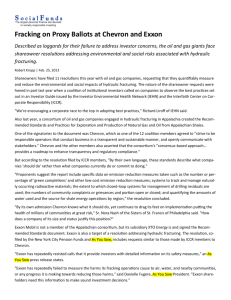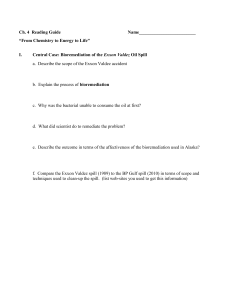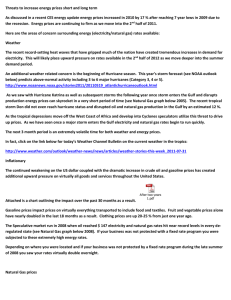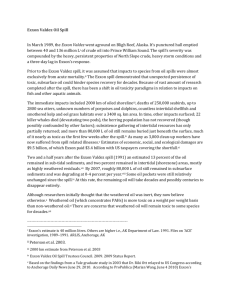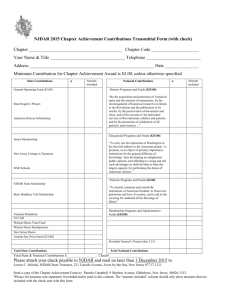Exxon History
advertisement
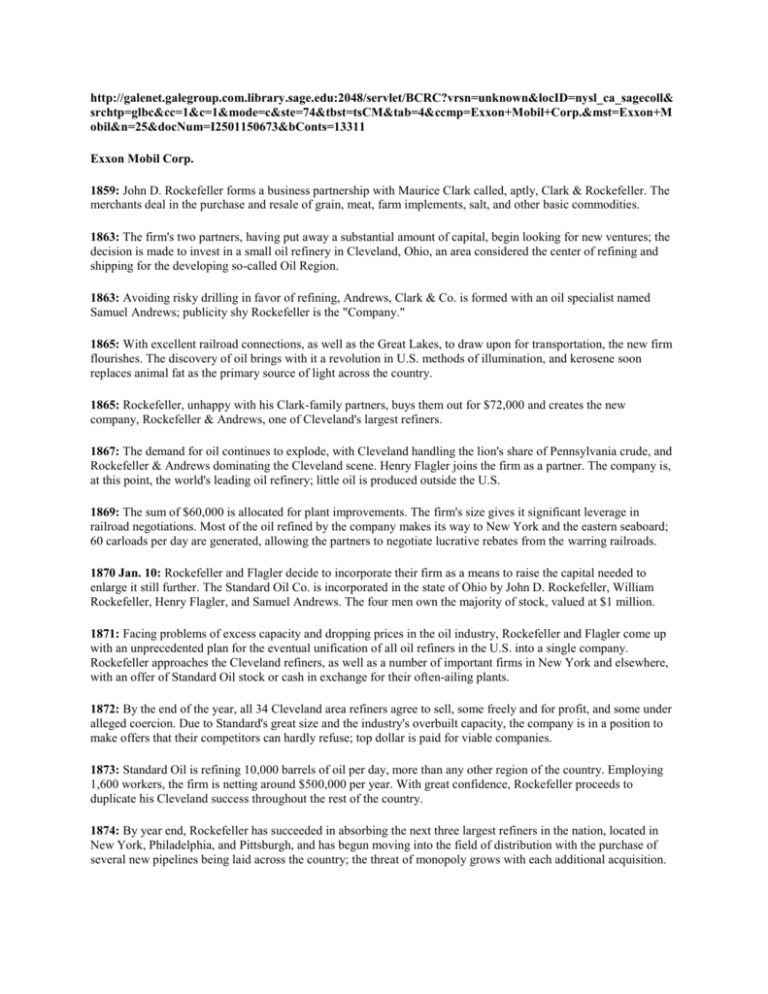
http://galenet.galegroup.com.library.sage.edu:2048/servlet/BCRC?vrsn=unknown&locID=nysl_ca_sagecoll& srchtp=glbc&cc=1&c=1&mode=c&ste=74&tbst=tsCM&tab=4&ccmp=Exxon+Mobil+Corp.&mst=Exxon+M obil&n=25&docNum=I2501150673&bConts=13311 Exxon Mobil Corp. 1859: John D. Rockefeller forms a business partnership with Maurice Clark called, aptly, Clark & Rockefeller. The merchants deal in the purchase and resale of grain, meat, farm implements, salt, and other basic commodities. 1863: The firm's two partners, having put away a substantial amount of capital, begin looking for new ventures; the decision is made to invest in a small oil refinery in Cleveland, Ohio, an area considered the center of refining and shipping for the developing so-called Oil Region. 1863: Avoiding risky drilling in favor of refining, Andrews, Clark & Co. is formed with an oil specialist named Samuel Andrews; publicity shy Rockefeller is the "Company." 1865: With excellent railroad connections, as well as the Great Lakes, to draw upon for transportation, the new firm flourishes. The discovery of oil brings with it a revolution in U.S. methods of illumination, and kerosene soon replaces animal fat as the primary source of light across the country. 1865: Rockefeller, unhappy with his Clark-family partners, buys them out for $72,000 and creates the new company, Rockefeller & Andrews, one of Cleveland's largest refiners. 1867: The demand for oil continues to explode, with Cleveland handling the lion's share of Pennsylvania crude, and Rockefeller & Andrews dominating the Cleveland scene. Henry Flagler joins the firm as a partner. The company is, at this point, the world's leading oil refinery; little oil is produced outside the U.S. 1869: The sum of $60,000 is allocated for plant improvements. The firm's size gives it significant leverage in railroad negotiations. Most of the oil refined by the company makes its way to New York and the eastern seaboard; 60 carloads per day are generated, allowing the partners to negotiate lucrative rebates from the warring railroads. 1870 Jan. 10: Rockefeller and Flagler decide to incorporate their firm as a means to raise the capital needed to enlarge it still further. The Standard Oil Co. is incorporated in the state of Ohio by John D. Rockefeller, William Rockefeller, Henry Flagler, and Samuel Andrews. The four men own the majority of stock, valued at $1 million. 1871: Facing problems of excess capacity and dropping prices in the oil industry, Rockefeller and Flagler come up with an unprecedented plan for the eventual unification of all oil refiners in the U.S. into a single company. Rockefeller approaches the Cleveland refiners, as well as a number of important firms in New York and elsewhere, with an offer of Standard Oil stock or cash in exchange for their often-ailing plants. 1872: By the end of the year, all 34 Cleveland area refiners agree to sell, some freely and for profit, and some under alleged coercion. Due to Standard's great size and the industry's overbuilt capacity, the company is in a position to make offers that their competitors can hardly refuse; top dollar is paid for viable companies. 1873: Standard Oil is refining 10,000 barrels of oil per day, more than any other region of the country. Employing 1,600 workers, the firm is netting around $500,000 per year. With great confidence, Rockefeller proceeds to duplicate his Cleveland success throughout the rest of the country. 1874: By year end, Rockefeller has succeeded in absorbing the next three largest refiners in the nation, located in New York, Philadelphia, and Pittsburgh, and has begun moving into the field of distribution with the purchase of several new pipelines being laid across the country; the threat of monopoly grows with each additional acquisition. 1878: Six years after beginning its annexation campaign, Standard Oil controls $33 million of the country's $35 million annual refining capacity, as well as a significant proportion of the nation's pipelines and oil tankers. At the age of 39, John D. Rockefeller is one of the five wealthiest men in the U.S. 1879: Nine Standard Oil officials are indicted by a Pennsylvania grand jury for violating state antimonopoly laws. Though the case is not pursued, it indicates the growing depth of negative feeling toward the massive company and is only the first among a long line of legal battles waged to curb its power. 1882: John D. Rockefeller and his associates create the Standard Oil Trust, the first such business trust in U.S. history. This move allows the company to overcome state laws restricting the activity of a corporation to its home state. Henceforth the Standard Oil Trust, domiciled in New York City, holds all assets of the various Standard Oil companies. Of the nine trustees, Rockefeller holds the largest number of shares. 1882: Together, the trust's 30 companies control 80% of the refineries and 90% of the oil pipelines in the U.S. and constitute the leading industrial organization in the world. The trust's first year's combined net earnings are $11.2 million, of which some $7 million is reinvested toward expansion. 1882: Standard Oil Co. of New Jersey, a refining and marketing organization, is incorporated; the firm is destined to become the dominant Standard company that will evolve into the Exxon Corp. 1884: A unit of the Standard Oil Trust buys control of Gilbert & Barker. 1886: The overseas trade in kerosene is especially important to Standard Oil of New Jersey, or "Jersey," which derives as much as three quarters of its sales from the export trade. Jersey's Bayonne, New York, refinery is soon the third largest in the Standard family, producing 10,000 to 12,000 barrels per day. 1886: In addition to producing and refining capacity, Standard is also gradually extending its distribution system from pipelines and bulk wholesalers toward the retailer and the private consumer. 1888: Standard Oil founds its first foreign affiliate, AngloAmerican Oil Co. Ltd. of London to market American oil in the British Isles. 1890: Standard Oil Co. of New York acquires a 40% interest in DAPG, a new German firm. The Sherman Antitrust Act is enacted into law, largely as a result of Standard's oil monopoly. Its passing lays the groundwork for a second major legal assault that will be directed against the mammoth firm. 1892: An Ohio Supreme Court order forbids the trust to continue operating Standard of Ohio. As a result, the trust is dissolved; taking advantage of newly liberalized state law in New Jersey, the Standard directors make Jersey the main vessel of their holdings. Standard Oil Co. of New Jersey becomes Standard Oil Co. (New Jersey) at this time. The new corporate structure now consists of only 20 much-enlarged companies with control held by the same few firms. 1892: Jersey adds a number of important manufacturing plants to its already impressive refining capacity and is the leading Standard unit. Like its sister firms, Jersey Standard combines both holding and operating functions. 1893: The Jersey Standard companies' operations extend around the world, including the marketing of kerosene in China with the help of a small tin lamp, known as "Mei Foo" or "Beautiful Companion," which the company's agents import and sell. 1896: Rockefeller retires from daily participation in Standard Oil at the age of 56. 1899: Jersey becomes the holding company for Standard Oil Interests. 1902: McClure's magazine publishes Ida M. Tarbell's series of articles on the history of Standard Oil. The articles take the company to task for such practices as obtaining railroad rate rebates denied its competitors, cutting prices to eliminate competition, and raising prices after competitors are eliminated. 1903: The Wright brothers make their successful flight at Kitty Hawk, North Carolina, using Standard gasoline. 1904: Jersey organizes its first affiliate engaged in oil production abroad in Rumania. 1905: A U.S. congressman from Kansas launches an investigation of Standard Oil's role in the falling price of crude in his state. The commissioner of the Bureau of Corporations, James R. Garfield, decides to widen the investigation into a study of the national oil industry--which is, in effect, Standard Oil. 1906: Garfield's critical report prompts a barrage of state lawsuits against Standard Oil (New Jersey) and, late in the year, a federal suit is filed charging the company, John D. Rockefeller, and others with running a monopoly. 1908: A pipeline begins carrying crude oil from Ohio to a refinery in Bayway, New Jersey. 1911: Over the last twelve years, Standard Oil has amassed profits of $830 million. In relative terms, its domination of the U.S. oil industry is decreasing; its percentage of total refining is down to 66% from the 90% of a generation before. But in absolute terms, Standard Oil has grown to monstrous proportions. After years of litigation, the U.S. Supreme Court upholds a lower court's conviction of the company for monopoly and restraint of trade. 1911: The Court orders the separation from Standard Oil Co. (New Jersey) of 33 of the major Standard Oil subsidiaries, including those which subsequently keep the Standard name. Jersey retains an equal number of smaller companies spread around the U.S. and overseas which, taken together, represent $285 million of the former Jersey's $600 million net value. 1911: Notable among the remaining holdings are refineries, producing companies, and foreign marketing affiliates. Absent are the pipelines needed to move oil from well to refinery, much of the former tanker fleet, and access to a number of important foreign markets, including Great Britain and the Far East. John D. Rockefeller steps down from his position as president. 1911: John D. Archbold takes over. His first challenge is to secure sufficient supplies of crude oil for Jersey's extensive refining and marketing capacity. 1911: Jersey's former subsidiaries continue selling crude to Jersey and, in reality, the dissolution decree has little immediate effect on the coordinated workings of the former Standard Oil group, but Jersey sets about to find its own sources of crude. Initial efforts toward foreign production meet with little success. 1913: John D. Rockefeller's fortune is estimated at $900 million. The oil baron's time is now spent redistributing his wealth in philanthropic pursuits, of which the general public is not particularly aware. 1915: Jersey reduces the workweek of all its employees to six eight-hour days. 1917: Walter Teagle is named president and dedicates himself to the prosperity of the company, while working to make it increasingly responsive to the expectations of employees and shareholders. Teagle is named to the National Petroleum War Service Committee and charged with coordinating the transportation of oil from the eastern seaboard to points abroad. By the war's end, Teagle is credited with making possible the smooth movement of oil to Europe's war zone. 1918: Jersey installs annuities, benefits, and an employee representation plan for its workers. Teagle conceives and oversees the editing of The Lamp, a magazine designed to serve as a communication vehicle for employees. 1919: Teagle arranges for the publication of Jersey's first annual report. For $17 million, Jersey acquires 50% of the Humble Oil & Refining Co. of Houston, Texas, a young but rapidly growing network of Texas producers which immediately assumes first place among Jersey's domestic suppliers. 1919: Although only the fifth-leading producer in Texas at the time of this purchase, Humble will soon become the dominant drilling company in the U.S. 1920: Jersey's stock is listed for the first time on the New York Stock Exchange. 1921: Jersey organizes the Standard Oil Co. of Venezuela. 1922: Jersey's Far Eastern affiliate, the NKPM, finds oil at Talant Akar, Sumatra. 1923: Jersey distributes its first road map. 1924: Jersey and General Motors jointly establish the Ethyl Gasoline Corp. 1926: Esso, a premium motor fuel, is placed on sale. 1927: Jersey transfers refining and marketing functions to Standard Oil Co. of New Jersey. Eight major marketing companies are incorporated by Jersey in Europe; these go on to sell a significant amount of refined products, most of them under the Esso brand name. 1928: Jersey buys the Venezuelan holdings of Creole Petroleum. Jersey and Socony-Vacuum, prodded by chronic shortages of crude, join three European companies in forming Iraq Petroleum Co. Jersey, Shell, and Anglo-Persian secretly agree to limit each firm's share of world production to their present relative amounts, attempting to limit competition and keep prices at high levels. 1928: As with Rockefeller's similar tactics 50 years earlier, it is not clear that the agreement is illegal, because its participants are located in a number of different countries, each with its own set of trade laws. 1933: Jersey and Socony-Vacuum merge their Far Eastern affiliates to form Standard-Vacuum Oil Co. 1934: Uniflo motor oil goes on sale. 1937: Bolivia expropriates Jersey's oil properties. Teagle is succeeded as president and CEO by William S. Farish, former president of Humble Oil & Refining. 1938: Mexico expropriates Jersey's oil properties. 1939: Patent agreements, which the company made ten years prior with Germany's chemical group, I.G. Farben, expire. Jersey chemists devise a process for producing synthetic toluene for TNT. 1942: The Justice Department brings suit against Jersey, claiming that the patent agreements made with I.G. Farben violated antitrust laws and slowed down the development of synthetic rubber. The charge proves inflammatory, and Jersey draws severe condemnation from congressional committees and newspaper columnists. 1942: Time consuming litigation leads to the signing of a consent decree that not only ends the remaining Farben contracts but provides for royalty-free licensing of the patents they covered. In denying wrongdoing, Jersey stresses the value of the agreements in developing products essential to the Allied war effort, including 100-octane aviation gasoline and toluene for TNT, as well as synthetic rubber for tires and inner tubes. 1942: The first fluid catalytic cracking unit goes on stream at Jersey's Baton Rouge, Louisiana, facility. The company completes construction on a 1,400 mile oil pipeline from Texas to New York. 1942: Jersey shares with the U.S. government the knowledge gained from its experience in coordinating widely separate producing, refining, and transportation operations to insure maximum supplies in minimum time; oil will become pivotal to the eventual Allied victory. 1943: Jersey consolidates its Venezuelan properties and operations under Creole Petroleum, which is the largest crude producer in the Jersey group and also the most profitable Jersey company of any kind. 1946: Creole Petroleum produces an average of 451,000 barrels per day, far more than the 309,000 by Humble and almost equal to all other Jersey drilling companies combined. 1948: Jersey acquires a 30% interest in the Arabian American Oil Co. for $74 million. 1950: Creole alone generates $157 million of the Jersey group's total net income of $408 million on sales of $517 million. Jersey's British affiliates, mainly marketers, show substantial sales of $283 million but a bottom line of only $2 million. Oil profits now lay in the production of crude, and the bulk of Jersey's crude comes from Latin America. 1950: The company's Far East holdings (from 1933 to 1961) never provide sizable amounts of crude oil. Surprisingly, gasoline is still not the company's leading product. That title goes to the group of residual fuel oils used to power ships and industrial plants and as a substitute for coal. 1951: The Trans-Arabian pipeline carries crude oil to the Mediterranean. 1954: Jersey and seven other companies negotiate a contract to operate the Iranian oil industry. 1955: Jersey establishes the Esso Education Foundation. 1957: Esso Research and Engineering (ER&E) gets a tract at Florham Park, New Jersey, for its research facility. 1958: ER&E receives a government contract to develop solid propellants for rockets. 1959: Jersey makes its first major oil discovery in Libya. CEO Eugene Holman initiates the consolidation of Jersey's principal domestic affiliates into a wholly owned Humble Oil & Refining Co. 1959: Greatly increased efficiency results as Humble becomes the nation's largest producer of crude oil, natural gas, and natural gas liquids and comes to rank first in the movement of crude oil and oil products by pipeline, barge and tankers, and in value of oil refined and products sold. 1960: Holman retires and is succeeded by Monroe J. Rathbone. Huge natural gas reserves are discovered in the Groningen province of the Netherlands. Growing nationalism and an increased awareness of the extraordinary power of the large oil companies leads to the formation of the Organization of Petroleum Exporting Countries (OPEC), and to a series of increasingly bitter confrontations between countries and companies over who should control the oil. 1962: Jersey enters the fertilizer manufacturing business in Colombia. 1963: Production begins in the 12% Jersey-owned Murban field in the Sheikdom of Abu Dhabi. 1965: Rathbone retires and is succeeded as CEO by Michael Haider. Esso Exploration Australia discovers gas in the Bass Strait on the southeast coast. 1966: Decentralization of foreign operations begins formally to take hold. Four regional organizations are expanded to coordinate the work of individual affiliates in Europe and Africa, Latin America, the Middle East, and the Pacific and Far East. The larger affiliates--Humble in the U.S., Creole in Venezuela, and Imperial in Canada--continue as regions unto themselves. 1966: These moves free Jersey's management to concentrate on broad policy issues and high priority decision making. All-around efficiency immediately improves as a result, and the system continues to work effectively for many years. Jersey's board expands to include two nonemployee directors; over time, that number will increase significantly. The "outsiders" are seen as bringing a fresh perspective on issues of growing relevance to the company. 1969: J. Kenneth Jamieson is named CEO. Jamieson confronts the problem of geographical restrictions on the company's use of the Standard Oil name in the U.S. The board brings to fruition a study that has been underway for several years on selecting a company name that could also serve as an uncontested national trademark. 1969: A team of linguistic experts, a leading design firm, and a battery of lawyers have been seeking a name that will be short, easy to pronounce and remember, with no adverse connotations in any language, and preferably with no meaning at all. A company committee, with outside assistance, examines thousands of possibilities before deciding on the coined word "Exxon." 1969: The word is secretly tested, and support is rallied before presentation to stockholders. Humble sponsors the voyage of the tanker S.S. Manhattan through the ice-clogged Northwest Passage. 1970: Jersey discovers oil and gas in the Jay Fields of Florida and Alabama. 1972: Standard Oil Co. (New Jersey) is officially renamed the Exxon Corp. 1973: Humble and most of the other domestic affiliates are merged into Exxon via new names, all of which include the word Exxon. Since no impediment to the use of Esso exists abroad, affiliates outside the U.S. remain unaffected by the change. Middle East oil-producing nations impose an oil embargo on the U.S. in response to U.S. sponsorship of Israel during the Arab-Israeli war. 1973: A resulting 400% price increase permanently changes the world's attitude to oil. The embargo spawns a prolonged recession as control of the oil is taken largely out of the hands of the oil companies. 1973: In response, oil firms begin exploration into new sources of energy and seek opportunities in other fields. For Exxon, the embargo causes increased corporate sales of the expensive oil, allowing it to double, within two years, its 1972 revenues of $20 billion. By 1980 that figure will rise to $100 billion. 1975: The principal assets of Creole Petroleum and other Venezuelan affiliates are nationalized. 1976: Major zinc-copper ore deposits are discovered in Wisconsin. 1977: The first oil flows south from Prudhoe Bay through the $8 billion, 800-mile Trans Alaska Pipeline System. 1979: Exxon begins seismic surveys offshore of the People's Republic of China. 1980: Exxon acquires a majority interest in Colorado's Colony project to process oil shale. 1981: The price of oil peaks and begins to fall for the remainder of the decade. Exxon's sales drop sharply, but OPEC's hold on the industry lessens. Having abandoned its forays into other areas, the company refocuses on the oil and gas business, cutting its assets and work force substantially to accommodate the drop in revenue without losing profitability. 1981: Production begins in 800 feet of water at Hondo field in California's Santa Barbara Channel. When built in 1976, the Hondo platform was the world's tallest offshore structure. 1982: Exxon commemorates its 100th anniversary. 1984: A joint venture polyethylene plant in Saudi Arabia begins operations. 1986: Exxon enters into a production contract with Hunt Oil Co. in the Yemen Arab Republic. 1987: Exxon Nuclear Co., Inc. is sold to Kraftwerk Union AG and Exxon's South African interests are divested. The company employs approximately 100,000 people worldwide. 1989 March 24: The oil tanker, Exxon Valdez, crashes in Prince William Sound off the port of Valdez, Alaska, spilling 260,000 barrels of crude oil. 1989: The Valdez disaster ends up costing Exxon $1.7 billion in this year alone. The company and its subsidiaries are faced with more than 170 civil and criminal lawsuits brought by state and federal governments and individuals. The resulting public relations damage threatens the company's future ability to gain drilling rights in other coastal areas of the U.S. 1991: Exxon distributes its gasoline through a network of 12,000 U.S. and 26,000 international service stations. The earnings of all marketing and refining activities are barely one-third of those derived from the production of crude. With a net income of $5.6 billion, Exxon ranks as the most profitable U.S. company for the year. Lawsuits relating to the Valdez spill are filed. 1993 July: Exxon Corp. and the Indonesian oil company Pertamina (state-owned) fail to reach a deal to drill the Natuna natural gas field in the South China Sea. xxon reportedly wants the Indonesian government, independent of Pertamina, to be jointly responsible with Exxon for any environmental damage. 1993: Exxon President Lee Raymond replaces Lawrence Rawl as chairman and CEO. 1994: An Alaska jury finds that Exxon's "recklessness" caused the 1989 Valdez spill, clearing the way for the rest of the trial in which plaintiffs will seek damages totaling $16.5 billion. However, the company is ordered to pay commercial fishermen $286.8 million, less than one-third of the plaintiffs' claims. 1994: Exxon employees are using the Rehabilitation Act of 1973 and the Americans With Disabilities Act to charge that Exxon's new drug and alcohol standards discriminate against them. Over 100 lawsuits have been filed. The standards, imposed after the Exxon Valdez oil spill, make workers with addiction histories ineligible for specific jobs. 1995 June: A meeting between U.S. VP Al Gore and Russian Prime Minister Viktor Chernomyrdin coincides with the June 30, 1995, signing of an agreement between Exxon and other oil and gas producers to develop Russian oil fields. Exxon has an exclusive deal worth $15 billion for drilling off of Sakhalin Island, and the company is also part of an oil company consortium that will drill Russia's Arctic Pechora Basin, worth a similar amount. 1995: Esso China Ltd., a subsidiary of Exxon Corp, plans oil exploration in western China on two tracts of land. Exxon Chemical Eastern Inc. and Esso China Inc. plan a deal with Sinopec Gaoqiao for petroleum chemicals plants in Shanghai. In addition, Esso China Inc. plans a joint venture to market petroleum and petroleum chemicals. 1996 Jan. 31: Exxon president Charles R. Sitter retires and is not replaced. Some observers say this move shows Exxon Chairman Lee Raymond's desire to concentrate his own power, while others say it is an economic measure. By eliminating the office of president, Exxon can save $1 million annually. 1996 May: Exxon is the world's second largest oil company; net profits hit a record $6.5 billion. 1996 June: Secret agreements between Exxon and plaintiffs in lawsuits resulting from the Exxon Valdez oil spill in Alaska are made public. The agreements would have reduced Exxon's punitive damage payout by requiring the plaintiffs to return a large portion of the punitive damages to Exxon. While Exxon defends this approach, the judge in the case voids the agreements. 1996 June: Exxon confirms that a Houston, Texas, jury has awarded the company $250 million in insurance coverage that Exxon was demanding from insurance underwriters, including Lloyd's of London, for a portion of its expenses as cargo owner arising from the Valdez accident. The final judgment will include interest and attorneys fees. 1997: Years of cost cutting and stock repurchasing pay off with annual profits of $7.5 billion, more than any other Fortune 500 company. Shareholder return for the year is a whopping 74%. 1998: Exxon Corp. and Mobil Corp. agree to merge in a record-setting $80 billion stock swap. If approved, the deal will create the largest public company in the world, headquartered in Houston, Texas. Mobil shareholders would own 30% of the new firm; Exxon shareholders, 70%. 1999 Nov. 30: Exxon and Mobil complete their merger, forming Exxon Mobil Corp., the world's top oil company. 2000: Exxon Mobil divests all of its Exxon operations in California. Sales reach a record $232.7 billion, making Exxon Mobil the largest company in the U.S. Exxon Mobil's $17.7 billion in annual profits are the highest ever recorded in U.S. business history. 2001 July: Stock splits two-for-one. 2001: Costing savings from the merger reach $4.6 billion. Sales decline 6.8% to $212.9 billion, and earnings drop to $15.5 billion. A U.S. Circuit Court of Appeals rules that the $5.5 billion fine levied against Exxon in the mid-1990s related to the Valdez oil spill is excessive and mandates that the Alaskan state court lower the fine. 2002: Along with cutting costs, Exxon also continues working to expand its presence in emerging markets. The firm plans to acquire a 50% stake in Advanced Elastomer Systems LP, a joint venture it operates with Solutia Inc. The firm also announces its intent to divest Intercor, its last coal mining holding. 2003 Dec.: Gradav, based in Sydney, Australia, pays $480 million for Exxon's oil and gas operations in the Australia Cooper-Eromanga Basin. 2003: Cost cutting efforts pay off as earnings soar 88% to $21.5 billion on revenues that grow 19% to more than $213 billion. Plans to acquire a stake in Russian oil giant Yukos are put on hold when Yukos CEO Mikhail Khordorkovsky is arrested. 2004 Feb.: Exxon pays $49 million to acquire a 40% stake in the Joint Development Zone of Nigeria and Sao Tome and Principe. 2004: Exxon reveals plans to divest 123 gas stations in southeastern Michigan by April 2005. 2005: In terms of market capitalization, which totals $334 billion, Exxon is the world's largest public oil concern. 2005 Aug.: Hurricane Katrina, a Category Five storm that destroys the city of New Orleans, Louisiana, forces Exxon to shutter refineries along the Gulf Coast. 2005 Sept.: In preparation for Hurricane Rita, Exxon halts operations at its refinery in Baytown, Texas, which produces 557,000 barrels of oil equivalent per day, more than any other refinery in the U.S. The firm also shutters its refinery in Beaumont, Texas. 2005 Sept.: PT Pertamina and Exxon forge a 30-year alliance to develop Cepu, a massive oil field in East Java, Indonesia, with anticipated crude oil reserves of 600 million barrels. 2005: Capital spending totals a record $18 billion. 2005 Nov.: Plans are made to hike production in Africa by 50 percent over a period of 10 years, supported by a $24 billion investment. 2006 June: In a deal worth $35 million, the company sells its gas stations in Peru to Refineria La Pampilla. 2006 July: ExxonMobil's East Area Additional Oil Recovery project begins operations. 2006 Sept.: In order to tap into the country's burgeoning automotive market, plans are made to establish 100 new lubricant outlets in China by the year's end. 2006 Oct.: A deal is made with China National Petroleum Corp. for the sale of all gas exports from the Far Eastern island of Sakhalin. 2007: Exxon Mobil ranks as the largest publicly traded oil company in the world. 2007: The company sells its chemical component additive operation to Dorf Ketal Chemicals India Pvt. 2007 Nov.: The commercial development of an on-vehicle hydrogen production system, designed for a fuel cellpowered lift truck, is pursued via a partnership with Israel's Ben Gurion University and QuestAir Technologies. 2007: Abstract: Exxon Mobil records an annual profit of $40.61 billion, the largest in U.S. history. 2008 June: Plans are made to exit gasoline retailing and sell the company's 2,220 service stations, while retailing the Exxon and Mobil brand names. Further Readings Afanasiev, Vladimir. "Well-Oiled: Exxon Has Shaped Itself Into a Nimble--and Even More Formidable-Giant." Barron's, 20 May, 1996: 17-18. Byrne, Harlan. "Exxon Reports Record Second Quarter." The Oil Daily, 21 July, 1995: 138. Curry, Kerry and David Wethe. "Exxon Mobil Completes Sale." Dallas Business Journal, 23 June, 2000: 48. "Exxon Defends Its 'Novel' Approach to Reducing Valdez Punitive Damages." The Wall Street Journal, 14 June, 1996. "ExxonMobil Started Up its East Area Additional Oil Recovery Project in Late July, in which Investments will Total $1.3bn." Petroleum Economist, Sept. 2006. "Exxon Plans to Sell its Gas Stations." The New York Times, 13 June 2008. "Exxon Mobil to Sink Billions into Africa; Oil Giant Plans to Raise Production There by 50 Percent." The Houston Chronicle, 10 Nov. 2005. "Nicholson, Alex. "Exxon Mobil Signs Agreement to Sell All Gas Exports from Russian Far East Project to China's CNPC." The America's Intelligence Wire, 23 Oct. 2006. "Exxon Sells Chemicals Unit." The Oil Daily, 22 Mar. 2007. Gold, Russell. "Exxon Racks Up Biggest Profit in U.S. History." The Wall Street Journal Eastern Edition, 2 Feb. 2008. Mouawad, Jad. "Despite a Decline, Exxon Mobil's Quarterly Profit Again Tops $10 Billion." The New York Times, 27 July 2007. "ExxonMobil Plans 20 Project Start-ups by 2008." Petroleum Economist, Apr. 2006. "Repsol Buys ExxonMobil's Gasoline Stations in Peru." World Refining & Fuels Today, 5 June 2006. Mouawad, Jad. "Exxon Works on Hydrogen Fuel." The Oil Daily, 16 Nov. 2007. "ExxonMobil to Open Additional 100 Lubricant Outlets in China by Yrend - Report." Europe Intelligence Wire, 28 Sept. 2006. "Exxon Mobil to Sell 123 Local Gas Stations." Crain's Detroit Business, 22 March, 2004, 1. "Exxon Mobil Signs Pact to Tap Oil in Indonesia." The Wall Street Journal, 19 Sept., 2005. "Exxon Sells Australia Asset." The Oil Daily, 15 Dec., 2003. Fan, Aliza. International Directory of Company Histories. Detroit: St. James Press. "Gore Visit to Moscow Timed to Coincide with Exxon Signing of Russian Mega-deal." The Oil Daily, 29 June, 1995: 1. "History." Exxon Mobil Corporation Homepage. http://www.exxonmobil.com, Aug., 2000. "Italy's Eni Challenges 'Big Oil' Scoring Deals on New Frontier." The Wall Street Journal, 18 Jan., 2005: A1. The Lamp: A Special Issue for Exxon's Centennial Anniversary. New York: Exxon Corp., 1982. Lewis, Mark. "Justice for Exxon Mobil." Forbes, 08 Nov., 2001. Longman, Philip and Jack Egan. "Why Big Oil is Getting a Lot Bigger." U.S. News & World Report, 14 Dec., 1998: 26. McCoy, Charles and Daniel Seligman. "Exxon's Little Problem." Fortune, 28 Nov., 1994: 193-194. "Oil, Gas Production on Gulf Coast." The Wall Street Journal, 22 Sept., 2005. Taylor, Gary. "Exxon Mobil Posts Decline in Operating Profits; Expects Future Growth." Chemical Market Reporter, 11 March, 2002: 4. Teitelbaum, Richard. "Exxon: Pumping Up Profits." Fortune, 28 April, 1997: 134. Source Citation: Exxon Mobil Corp. Notable Corporate Chronologies. Online Edition. Gale, 2009. Reproduced in Business and Company Resource Center. Farmington Hills, Mich.:Gale Group. 2010. http://galenet.galegroup.com/servlet/BCRC Document Number: I2501150673
